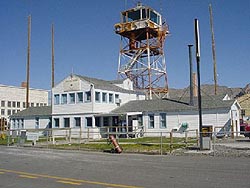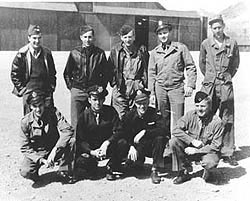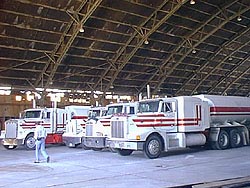
Wendover Air Force Base, located just south of the town of Wendover, Utah, played an important role in training heavy bombardment crews and ushering in the atomic age. The base was first conceived in 1939 when the Army Air Corps commenced an extensive expansion program. High on the Air Corps list was the construction of adequate bombing and gunnery ranges. By 1940 a site was located at Wendover, and work began in November of that year. Initially the Air Corps desired some three million acres of land of which 90 percent was public domain. However, because of grazing commitments to local ranchers and farmers, only one and a half million acres were allocated. On April 6, 1942, the first training unit arrived and found the area ideal for bombing and gunnery practice due to the terrain of the region and lack of large population centers. Twenty-one heavy bomb groups trained in Wendover including the 306th BG (first to daylight bomb Nazi Germany), the famed 100th BG (known as the bloody 100th due to aircraft losses) and the Flying Tigers 308th Bomb Group which served in China, Burma and India. Additionally, members of three bomb groups trained in Wendover won the Medal of Honor. The base also served as the test and training site for the atomic bomb and the 509th Composite Group under the command of Colonel Paul W. Tibbets, Jr. It was Colonel Tibbits, flying his B-29, "Enola Gay," who dropped the atomic bomb on Hiroshima in August 1945.

The 509th Group was organized December 17, 1944, and trained at Wendover until May 1945, when they left for Tinian Island in the Marianas. During the group's stay at Wendover, the base became a maximum-security area with signs stating, "What you see here, What you do here, What you hear here, Stays here." Information about the group's mission was so restricted that even members of the 509th did not know the purpose of this training, although Colonel Tibbets was briefed on the Manhattan Project (the code name the U.S. government used for its plan to build an atomic bomb) in September 1944 and given authority to add modifications necessary to make the B-29 capable of delivering the atomic bomb. The crew of the Enola Gay proved that an atomic bomb could be used under combat conditions.

During the final days of World War II and for a short time in the late 1940s and early 1950s, Wendover played a role in the U.S. guided missile program. The first flight of an unmanned U.S. Air Force vehicle to break the sound barrier occurred over the Wendover bombing range. The American "JB-2," a version of the German V-1 rocket, was also extensively tested at Wendover.
Wendover Air Force Base was closed by the Air Force in 1963. The buildings that remain are typical of military buildings constructed during World War II. The frame buildings were neglected after the base's closing, and fell into disrepair until the Historic Wendover Air Field Museum restored them for the benefit of the public.
Visit the National Park Service Travel American Aviation to learn more about Aviation related Historic Sites.
The Preserve America program funded a Tooele County project to create a documentary film about WWII home-front training at Wendover Air Force Base. Additionally, funding helped create a master plan to restore the airfield in 2006.
Tags
- aviation history
- national register of historic places
- nrhp
- airplanes
- national landmarks
- heritage travel itineraries
- discover our shared heritage
- historic properties
- travel itineraries
- utah
- military aviation
- historic air fields
- historic locations
- historic preservation fund
- historic preservation grants
- preserve america
Last updated: August 20, 2021
